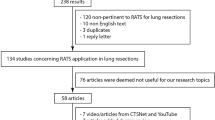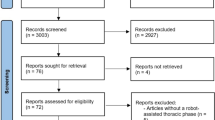Abstract
The present study intends to investigate the clinical value of complete video-assisted thoracoscopic surgery (c-VATS) lobectomy in treatment of elderly patients with non-small cell lung cancer (NSCLC). A total of 100 cases of elderly patients with NSCLC admitted in our hospital from March 2012 to March 2014 were enrolled in this study and divided into the research group (n = 50) and control group (n = 50) by random sampling method. All patients in the research group underwent c-VATS lobectomy, while those in the control group underwent conventional lobectomy via thoracotomy. The duration of operation, length of incision, intraoperative blood loss, indwelling time of drainage tube, postoperative complication rate, the number of excised lymph nodes, the time of removing stitches, mean length of stay, and vision analog score (VAS) in two groups were observed and compared. The pulmonary function and arterial blood gas before surgery and six months after surgery in two groups were detected and compared. A regular follow-up study was conducted after surgery. The one-year survival rate in two groups were calculated and compared. The differences in the duration of operation, length of incision, indwelling time of drainage tube, postoperative complication rate, the time of removing stitches, mean length of stay, and VAS score between two groups were statistically significant (all P < 0.05). The postoperative vital capacity, forced vital capacity (FVC), forced expiratory volume in 1 s (FEV1), FEV1 to FVC ratio, 25 and 75 % of forced expiratory flow, and the degree of decline in maximum ventilatory volume per minute compared to that before surgery in c-VATS group were significantly less than those in conventional thoracotomy group (all P < 0.05). The degree of advance in postoperative partial pressure of arterial oxygen and saturation of arterial oxygen compared to those before surgery, and the degree of decline in partial pressure of arterial carbon dioxide compared to that before surgery were significantly greater than those in conventional thoracotomy group (all P < 0.05). The differences in intraoperative blood loss, the number of excised lymph nodes, and one-year survival rate were not statistically significant (all P > 0.05). VATS lobectomy has advantages of smaller incision in treatment of NSCLC, faster recovery, and better prognosis compared to traditional therapy.
Similar content being viewed by others
References
Yang, F., Li, X., Wang, J., et al. (2011). Video-assisted thoracoscopic surgery lobectomy: A Series of consecutive 300 patients and a 3-year follow-up. Chinese Journal of Clinical Thoracic and Cardiovascular Surgery, 18(2), 95–98. Chinese Version.
Zhang, Z. R., Liu, D. R., Guo, Y. Q., et al. (2011). The common causes of conversion of VATS during operation for 248 non-small cell lung cancers. Chinese Journal of Lung Cancer, 14(6), 523–528. Chinese Version.
Ichinose, J., Kohno, T., Fujimori, S., et al. (2010). Locoregional control of thoracoscopic lobectomy with selective lymphadenectomy for lung cancer. Annals of Thoracic Surgery, 90(1), 235–239.
Park, B. J. (2011). Is surgical morbidity decreased with minimally invasive lobectomy? Cancer Journal, 17(1), 18–22.
Darling, G. E., Allen, M. S., Decker, P. A., et al. (2011). Randomized trial of mediastinal lymph node sampling versus complete lymphadenectomy during pulmonary resection in the patient with N0 or N1 (less than hilar) non-small cell carcinoma: Results of the American College of Surgery Oncology Group Z0030 Trial. Journal of Thoracic and Cardiovascular Surgery, 141(3), 662–670.
Wang, J. W., Yu, X. Y., Fang, Z., et al. (2013). Case-control study of complete video-assisted thoracosopic surgery lobectomy and traditional lobectomy via thoracotomy in treatment of patients with non-small cell lung cancer. Chinese Journal of Postgraduates of Medicine, 36(25), 65–67. Chinese Version.
Zhao, Y., Sun, Z. Y., Gu, M. W., et al. (2012). Case-control study of unidirectional complete video-assisted thoracosopic surgery lobectomy and traditional lobectomy via thoracotomy in treatment of patients with early non-small cell lung cancer. Hebei Medical Journal, 34(10), 1503–1505. Chinese Version.
Zhang, X. L., & Liu, L. X. (2012). Progress of thoracoscopic pulmonary segmentectomy for early-stage non-small cell lung cancer. Chinese Journal of Clinical Thoracic and Cardiovascular Surgery, 19(2), 177–180. Chinese Version.
Chen, S. (2013). Current status of video-assisted thoracoscopic pulmonary segmentectomy in the treatment for early stage non-small cell lung cancer. Journal of Oncology, 19(10), 754–757. Chinese Version.
Zhong, C., Yao, F., & Zhao, H. (2013). Clinical outcomes of thoracoscopic lobectomy for patients with clinical N0 and pathologic N2 non-small cell lung cancer. Annals of Thoracic Surgery, 95(3), 987–992.
Ceppa, D. P., Kosinski, A. S., Berry, M. F., et al. (2012). Thoracoscopic lobectomy has increasing benefit in patients with poor pulmonary function: A society of thoracic surgeons database analysis. Annals of Surgery, 256(3), 487–493.
Li, Y., & Wang, J. (2012). Comparison of clinical outcomes for patients with clinical N0 and pathologic N2 non-small cell lung cancer after thoracoscopic lobectomy and open lobectomy: A retrospective analysis of 76 patients. Journal of Surgical Oncology, 106(4), 431–435.
Shao, W., Liu, J., Liang, W., et al. (2014). Safety and feasibility of video-assisted thoracoscopic surgery for stage IIIA lung cancer. Chinese Journal of Cancer Research, 26(4), 418–422.
Choi, S. M., Heo, E. Y., Lee, J., et al. (2014). Characteristics of benign solitary pulmonary nodules confirmed by diagnostic video-assisted thoracoscopic surgery. The Clinical Respiratory Journal. doi:10.1111/crj.12200.
Peel, J., & Darling, G. (2014). Left video-assisted thoracoscopic surgery esophagectomy in a patient with situs inversus totalis and Kartagener syndrome. Annals of Thoracic Surgery, 98(2), 706–708.
Sonoda, H., Shimizu, T., Takebayashi, K., et al. (2014). Minimally invasive surgery using the open magnetic resonance imaging system combined with video-assisted thoracoscopic surgery for synchronous hepatic and pulmonary metastases from colorectal cancer: Report of four cases. Surgery Today, 45(5), 652–658.
Komatsu, T., Kino, A., Inoue, M., et al. (2014). Paravertebral block for video-assisted thoracoscopic surgery: Analgesic effectiveness and role in fast-track surgery. International Journal of Surgery, 12(9), 936–939.
Author information
Authors and Affiliations
Corresponding author
Rights and permissions
About this article
Cite this article
Xue, Y., Wang, Y.Y., Zhang, K. et al. A Study of Complete Video-Assisted Thoracoscopic Surgery Lobectomy in Treatment of Elderly Patients with Non-Small Cell Lung Cancer: Curative Effect and Impact on Clinical Prognosis. Cell Biochem Biophys 73, 399–404 (2015). https://doi.org/10.1007/s12013-015-0649-x
Published:
Issue Date:
DOI: https://doi.org/10.1007/s12013-015-0649-x




